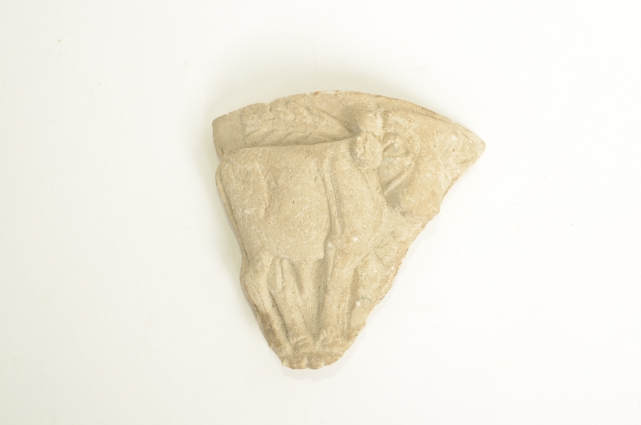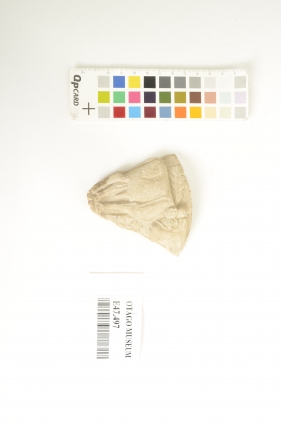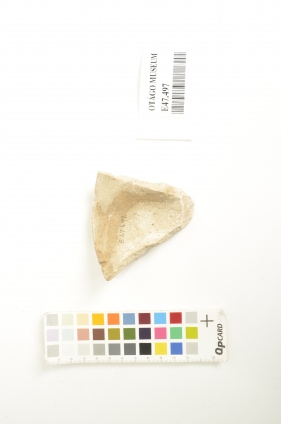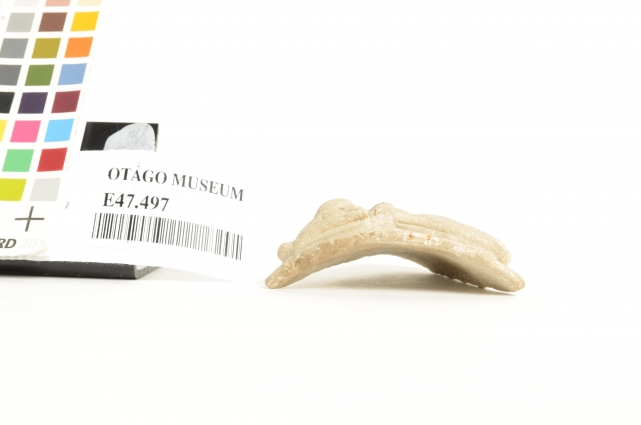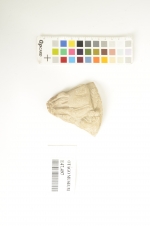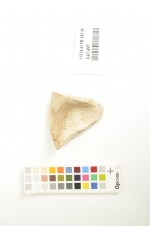Sherd, E47.497
Physical Description
Carved limestone rim sherd from a conical vessel. Triangular in shape, the whole shape is filled out with a relief carving of a bull in profile. Head is turned towards the viewer. Above the bull is a stalk of ?wheat.
Research Notes
From Christie's sale 7376. Lot notes:
"...Stone vessels of this type - highly prized luxury goods made of imported stone and carved with great skill - dating to the late Uruk period were often found in temples or palaces. Bull cups are thought to have been made for ceremonial use in temples (the sacred herd motif of processing bulls is known from cups and cylinder seals of this period) and may be associated with fertility cults; Inanna's husband Dumuzi-Tammuz was closely associated with vegetation, flocks and cattle and the cult of the sacred marriage between them, with its associated rites designed to ensure productivity and fertility, originated at Uruk.
For a similar stone bowl decorated with bulls and ears of corn, cf. H. Frankfort, The Art and Architecture of the Ancient Orient, London, 1963, p. 11, pl. 5b; "... here a bull with an ear of barley, four times repeated round the vase - which evokes the goddess or god. But the heads of the bulls project from the vase, they are almost worked in the round, and this device recurs on a number of sculptured stone vases". For a very similar example in the Louvre, cf. A. Caubet and M. Bernus-Taylor, The Louvre, Near Eastern Antiquities, Paris, 1991, p. 19, no. AO 21989. Also see, J. Aruz (ed.), Art of the First Cities, exhibition catalogue, The Metropolitan Museum of Art, New York, 2003, p. 42, no. 12, for a stone bowl with bulls in relief in the Vorderasiatische Museum, Berlin, no. VA 10113; "The considerable work involved in creating stone vessels and the fact that the stone was imported gave them great value. While fragile ceramic vessels had to be continually replaced and therefore likely to reflect changes in taste ... stone vessels tended to be produced in a limited range of shapes and to be used for generations."" —Scott Reeves
"...Stone vessels of this type - highly prized luxury goods made of imported stone and carved with great skill - dating to the late Uruk period were often found in temples or palaces. Bull cups are thought to have been made for ceremonial use in temples (the sacred herd motif of processing bulls is known from cups and cylinder seals of this period) and may be associated with fertility cults; Inanna's husband Dumuzi-Tammuz was closely associated with vegetation, flocks and cattle and the cult of the sacred marriage between them, with its associated rites designed to ensure productivity and fertility, originated at Uruk.
For a similar stone bowl decorated with bulls and ears of corn, cf. H. Frankfort, The Art and Architecture of the Ancient Orient, London, 1963, p. 11, pl. 5b; "... here a bull with an ear of barley, four times repeated round the vase - which evokes the goddess or god. But the heads of the bulls project from the vase, they are almost worked in the round, and this device recurs on a number of sculptured stone vases". For a very similar example in the Louvre, cf. A. Caubet and M. Bernus-Taylor, The Louvre, Near Eastern Antiquities, Paris, 1991, p. 19, no. AO 21989. Also see, J. Aruz (ed.), Art of the First Cities, exhibition catalogue, The Metropolitan Museum of Art, New York, 2003, p. 42, no. 12, for a stone bowl with bulls in relief in the Vorderasiatische Museum, Berlin, no. VA 10113; "The considerable work involved in creating stone vessels and the fact that the stone was imported gave them great value. While fragile ceramic vessels had to be continually replaced and therefore likely to reflect changes in taste ... stone vessels tended to be produced in a limited range of shapes and to be used for generations."" —Scott Reeves
Provenance
?Locality
Mesopotamia
Measurements
Maximum dimensions (H x W x D): 78.2 x 80.4 x 25mmAll Rights Reserved

